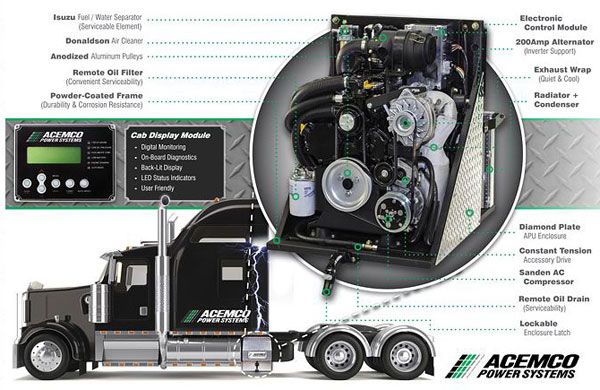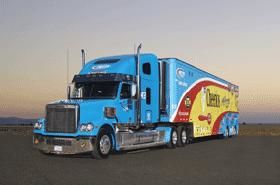Why Are Fleet OTR Trucks Often Cramped For Living Space?
Topic 19525 | Page 1
Hahhaha. ...wow..really?
I don't know any major carrier using them.
1. Costs too much
2 Fuel consumption is thru the roof
3. The weight of that thing would cut the weight of the freight in half...meaning no profits at all.
I'm perfectly fine in my FL....BTW...I'd love to see you try to get a parking spot with that. Let a newbie hit something or back into a door with that.
Lmao, try taking that thing into a shipper or receiver on the east coast or border towns near Mexico. Not going to happen. Also do you know how expensive those trucks are? My freightliner has plenty of room, also being a minimalist of sorts, some of my cabinets are barely even full.
Your asking for too much. Sure they need drivers, but just cause you get a CDL doesn't mean you don't have to prove yourself. These trucks take a while to figure out. Been driving for a year and still struggle with some right turns, no way a rookie could drive a super sleeper.
CDL:
Commercial Driver's License (CDL)
A CDL is required to drive any of the following vehicles:
- Any combination of vehicles with a gross combined weight rating (GCWR) of 26,001 or more pounds, providing the gross vehicle weight rating (GVWR) of the vehicle being towed is in excess of 10,000 pounds.
- Any single vehicle with a GVWR of 26,001 or more pounds, or any such vehicle towing another not in excess of 10,000 pounds.
- Any vehicle, regardless of size, designed to transport 16 or more persons, including the driver.
- Any vehicle required by federal regulations to be placarded while transporting hazardous materials.
Shipper:
The customer who is shipping the freight. This is where the driver will pick up a load and then deliver it to the receiver or consignee.
HOS:
Hours Of Service
HOS refers to the logbook hours of service regulations.I've seen bedbuggers with trucks about half that size, but those are typically the only trucks I see with enormous sleepers on them. Maybe you should look into doing that kind of work. My brother had a friend who was a bedbugger during college, and paid his tuition that way by working over the summer driving, but that was waaaaay back in the late '70s and early '80s, when people had chauffeur's licenses instead of CDLs. I don't know that there are any bedbuggers here on the forum, and I don't know how you get started in that part of the industry, so not much help there.
CDL:
Commercial Driver's License (CDL)
A CDL is required to drive any of the following vehicles:
- Any combination of vehicles with a gross combined weight rating (GCWR) of 26,001 or more pounds, providing the gross vehicle weight rating (GVWR) of the vehicle being towed is in excess of 10,000 pounds.
- Any single vehicle with a GVWR of 26,001 or more pounds, or any such vehicle towing another not in excess of 10,000 pounds.
- Any vehicle, regardless of size, designed to transport 16 or more persons, including the driver.
- Any vehicle required by federal regulations to be placarded while transporting hazardous materials.
HOS:
Hours Of Service
HOS refers to the logbook hours of service regulations.Let's get real, ravenswood. Driver accommodations take up weight. The more freight a truck can haul, the more revenue. Extra cabinets and dining tables don't make revenue.
Not a single major company will do that for any driver. A bunk, some cabinets, and a flat place/"counter" is about the limits. Bonus points for an APU.
APU:
Auxiliary Power Unit
On tractor trailers, and APU is a small diesel engine that powers a heat and air conditioning unit while charging the truck's main batteries at the same time. This allows the driver to remain comfortable in the cab and have access to electric power without running the main truck engine.
Having an APU helps save money in fuel costs and saves wear and tear on the main engine, though they tend to be expensive to install and maintain. Therefore only a very small percentage of the trucks on the road today come equipped with an APU.

As everyone else stated. It isn't gonna happen. TBH, a lot of company do get the larger "normal" sized sleepers. You usually at least have a 70"+ midroof sleeper if not a high rise (condo) sleeper. You are not getting stuck with a little "coffin" sleeper. Unless it is for local use with the occasional overnight run. The most common chance of having a really small sleeper is going with Prime and opting to drive a 'light weight' truck. You get paid 5 cents more a mile to do it too. Even then you are still going to get a 60" mid roof instead of a 72" high rise.
Even a standard 72" high rise freightliner Cascadia brand new is going to cost a company around $185,000 a piece. Those big huge sleepers and especially the custom sleepers are in the $250,000 to $400,000+ price range. If you want something that big, go ahead and mortgage your soul for it.
HOS:
Hours Of Service
HOS refers to the logbook hours of service regulations.Money--that's why. And like others have said, good luck learning to maneuver that thing as a rookie right out of training.

I have a tremendous idea.....all companies should just use daycabs but provide rooms at the nearest Hilton every day for drivers to take our 10hr breaks. We should also be provided dining at a 5 star restaurant at least twice a day. For 34hr resets we should be provided accommodations to a luxury all-inclusive resort, if not near one, airfare should also be provided, 1st class of course.
Get a grip Ravenswood. You start a company and provide your drivers with such trucks. Best of luck with that.
TWIC:
Transportation Worker Identification Credential
Truck drivers who regularly pick up from or deliver to the shipping ports will often be required to carry a TWIC card.
Your TWIC is a tamper-resistant biometric card which acts as both your identification in secure areas, as well as an indicator of you having passed the necessary security clearance. TWIC cards are valid for five years. The issuance of TWIC cards is overseen by the Transportation Security Administration and the Department of Homeland Security.
Ravenswood....most of your posts are about what drivers want and whether we should be concerned about self driving trucks. Did you ever wonder WHY the companies want self driven trucks?
Maybe because some drivers have ridiculous demands. These trucks are our jobs...not our residence. Yes I live on my truck, but it is not mine. It is a company vehicle in which I have been given really good amenities to make my life easier. You seem to think it is a living space first, and a corporate asset last.
I keep wondering why you are some spending so much time constantly criticizing an industry which many of us love. Why are you here if you are so critical of trucking?

I have a tremendous idea.....all companies should just use daycabs but provide rooms at the nearest Hilton every day for drivers to take our 10hr breaks. We should also be provided dining at a 5 star restaurant at least twice a day. For 34hr resets we should be provided accommodations to a luxury all-inclusive resort, if not near one, airfare should also be provided, 1st class of course.
Get a grip Ravenswood. You start a company and provide your drivers with such trucks. Best of luck with that.
So, companies have to balance between costs and somehow making trucking ATTRACTIVE enough to LURE new drivers. Apparently, there are enough "tough nuts" who demand little in terms of creature comforts in this trade to fill needed driver positions. Companies have not YET become DESPERATE enough to be compelled to give drivers first class Hilton treatment over the road , I gather. Or, trucking UNIONS have not done collective bargaining hard enough maybe.
Why don't companies have dorms at all their nationwide terminals for drivers to camp out at while off the clock? The dorms could be like a small studio apartment complete with bed, kitchen, toilet, sink and shower.
Terminal:
A facility where trucking companies operate out of, or their "home base" if you will. A lot of major companies have multiple terminals around the country which usually consist of the main office building, a drop lot for trailers, and sometimes a repair shop and wash facilities.
Over The Road:
Over The Road
OTR driving normally means you'll be hauling freight to various customers throughout your company's hauling region. It often entails being gone from home for two to three weeks at a time.
TWIC:
Transportation Worker Identification Credential
Truck drivers who regularly pick up from or deliver to the shipping ports will often be required to carry a TWIC card.
Your TWIC is a tamper-resistant biometric card which acts as both your identification in secure areas, as well as an indicator of you having passed the necessary security clearance. TWIC cards are valid for five years. The issuance of TWIC cards is overseen by the Transportation Security Administration and the Department of Homeland Security.
New Reply:
New! Check out our help videos for a better understanding of our forum features

















Preview:
This topic has the following tags:
Advice For New Truck Drivers Becoming A Truck Driver Life On The Road Truck Driving Lifestyle Trucking Industry Concerns







 TT On Facebook
TT On Facebook
If companies need drivers so badly, one might think the LARGEST on-board living spaces, cab/sleeper configurations, in terms of SHEER volume, available on the market would be offered to drivers. I know there are much larger sleeper units available than what is seen on many fleet tractors.
I have browsed the Kenworth website before and know what the market offers.
Now, here is more of an OTR CAMPER than a "sleeper berth".
https://www.youtube.com/watch?v=UJOFVJgtPDI
Does your company offer on-board living this spacious?
OTR:
Over The Road
OTR driving normally means you'll be hauling freight to various customers throughout your company's hauling region. It often entails being gone from home for two to three weeks at a time.
Sleeper Berth:
The portion of the tractor behind the seats which acts as the "living space" for the driver. It generally contains a bed (or bunk beds), cabinets, lights, temperature control knobs, and 12 volt plugs for power.